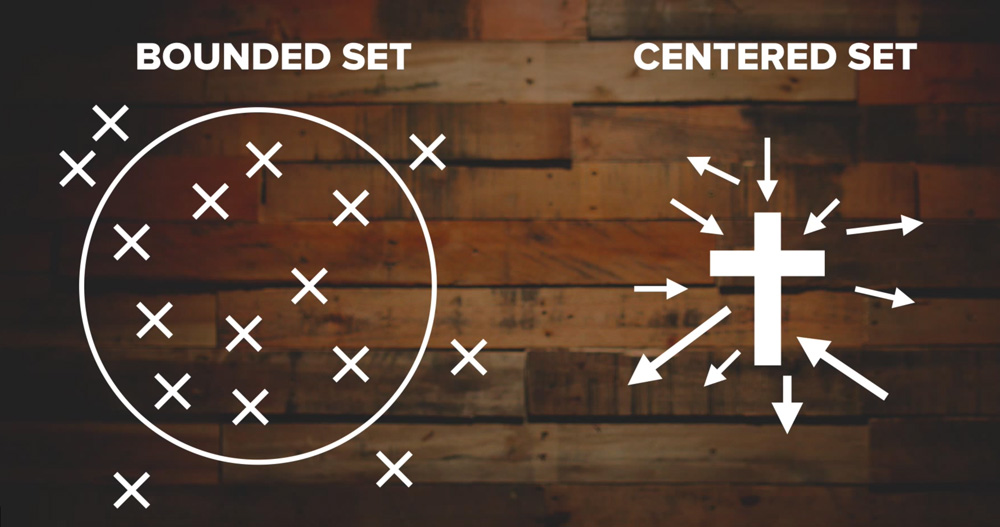We need to equip every disciple to view the world through two sets of lenses. One lens is those people with whom they have ongoing relationships, so this is; their friends, their family, their neighbors, their co-workers, their classmates, people with whom they interact on a regular basis. The other lens is every people, tribe, tongue, and nation. It’s people who you don’t interact with on a regular basis and maybe you don’t have much in common with them.
We need to see the world in both ways, with both of these subsets in view. I want to talk a little right now about that first world. Those people with whom we interact on a regular basis.
To get people to think of this portion of the world, I like to get them to make a list of a hundred people.
To me that often approximates this world of their friends, family, neighbors, co-workers, and classmates that they interact with on a regular basis and that they know how to get ahold of them, they know a little bit about them and so on.

List of 100 is included in “Relational Stewardship – List of 100” in session 2 of the Zúme Training.
Interacting with those people, I believe we are called to be patient and persistent. I love to illustrate this with a story of my father.
My father grew up in a pagan family, never went to church. They were farmers. In his junior year in high school on Easter Sunday, he was out plowing a field with their mule.
A classmate from his high school came driving across the field in his pickup and invited my dad to go to church with them. My dad said, “No, I have to get this field plowed today. It’s going to take all day, so I can’t go with you, sorry.”
So the next Sunday the kid came back, my dad made an excuse and again didn’t go with him. This kept happening over and over and over.
On my dad’s senior year, Easter Sunday, this kid was driving back across the field. My dad was in the same field, plowing with the same mule, and he realized when he saw this kid coming, this kid has been after me for 53 weeks. “I’ve got to do something to get this fanatic off my back.”
So when he came, my dad said, “I have to get this field plowed, it’s gonna take all day, I can’t go with you, but if you come back next week, I’ll go with you.” He figured that was the only way to get rid of this kid.
So the next week, 54th week the kid comes back, my dad goes to church with him, he hears the gospel for the first time. The pastor’s preaching on first John 1:9 and 10 … “if we confess our sins he’s faithful and just to forgive us our sins and cleanse us from all unrighteousness”.
My dad’s heart was touched and the next week he ended up giving his life to Christ.
He then went on to become a missionary. Then I was born into a Christian family, a missionary family, and then I became a missionary.
Now I’ve met this guy who was so persistent with my dad. He never went to school a day past high school. He never left this teeny tiny town where he lived. He worked in this little two-bit hardware store and never did anything significant from an earthly perspective. Never travelled. Nothing.
But, that man touched the world because he was faithful. He was persistent, he was patient in reaching out to my dad, and he impacted the world.
Interacting with those people, I believe we are called to be patient and persistent.
Bounded Set – Centered Set
Now we often think in terms of bounded set when we think of the kingdom. So in this diagram, you’ll note the circle indicates the kingdom. The X’s that are in the circle, these are people who are in the kingdom. The X’s that are outside the circle are those outside the kingdom.

And this is accurate … it’s helpful. It’s a good way to look at it and in fact it highlights an important principle of emphasizing those outside the kingdom. Jesus told the story of the Shepherd, who leaves the 99 sheep in the fold and goes out searching for the one lost sheep. So this bounded set thinking helps to prioritize those outside the kingdom and that’s good, that’s appropriate.
But I think it’s helpful to supplement that thinking with centered set thinking.
In a centered set, you’re not looking at points, but you’re looking at the vectors that are represented by these rays in this diagram. The rays that are in the set are the ones pointed toward the center of the set. The rays pointed away from the center are not in the set.
So what is being in the set? Being in the kingdom means you’re pointed toward Christ. He is your Lord. He is the most important thing in your life. He is who you’re living for and so that determines whether you in the kingdom or not.
There are two characteristics about every one of these rays: direction and magnitude. The direction determines if you’re in the set. Magnitude determines the passion with which you’re either pursuing Christ or you are pursuing something else.
Being in the kingdom means you’re pointed toward Christ.
For example, you remember Jesus said those who are forgiven much, love much. So we’re all familiar with people who have had a terrible background. Then God saves them and then they are passionate for him. They realize how undeserving they are of His grace and so they’re passionate and loving and pursuing God. Someone like that, the ray would be very long.
There are other people who follow Christ, but they don’t seem passionate. They seem almost lukewarm. They would have a very short ray representing their lives.
You can have a ray that’s close to the cross for example, but pointed away from it. That might represent someone who’s in the church, and they may think they’re saved because they’re in the church, but actually they’re pursuing other things not Christ.
This is particularly helpful in my mind in thinking about those people with whom I have ongoing relationships, because I don’t only care are they pointed toward Christ or away from him.
If they’re pointed away from him, I want to help turn them toward Christ. But if they’re pointed toward Christ, I want to help them increase their faithfulness — increase their passion for Christ — to increase the magnitude of their vector.
We talk about stewarding our money, stewarding our time, stewarding our resources, but we also need to steward our relationships.
So every time I come in contact with someone, the question is: Am I encouraging them to love and good works? Am I spurring them on to love and good works? Am I encouraging them in their faith? Am I drawing them closer to God? Every time I’m in contact with someone, am I either turning them towards Christ or increasing the magnitude of their love for him?
This is a good guide for me in how I can be relating to any person that’s in my network of relationships. Even if someone’s far more mature than I am spiritually, they still need my encouragement.
No one loves God with all their heart, mind, soul, and strength 24 hours a day, 365 days a year. Because that’s the case, we all need encouragement in our faith. We need to be concerned not only with drawing people to Christ, but then helping them follow him more completely. This is especially a factor in people that we relate to on a regular basis.
This is what I refer to as relational stewardship. We talk about stewarding our money, stewarding our time, stewarding our resources, but we also need to steward our relationships.
More Multiplication Concepts
This concept is part of the “Multiplication Concepts” series by Curtis Sergeant. Consider working through the entire series and challenging someone you know to do it with you. See an entire list of the concepts in the article titled “Multiplication Concepts”.
This same concept is taught in the Zúme Training course using video animation and is translated into 40 languages. Find more training on this concept with “Relational Stewardship – List of 100” in session 2 of the Zúme Training.
Zúme Training is an on-line and in-life learning experience designed for small groups who follow Jesus to learn how to obey His Great Commission and make disciples who multiply.
